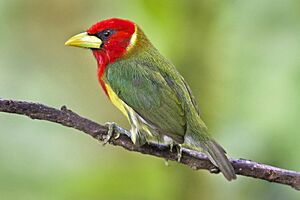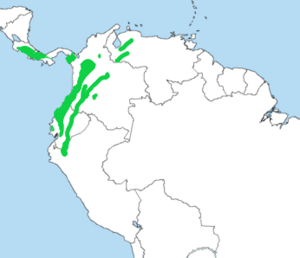Red-headed barbet facts for kids
Quick facts for kids Red-headed barbet |
|
|---|---|
 |
|
 |
|
| E. b. aequatorialis in Ecuador Male (above) and female (below) |
|
| Conservation status | |
| Scientific classification | |
| Genus: |
Eubucco
|
| Species: |
bourcierii
|
 |
|

The Red-headed Barbet (Eubucco bourcierii) is a colorful bird found in the forests of Central and South America. It belongs to the Capitonidae family, known as the New World barbets. These birds live in countries like Costa Rica, Panama, Colombia, Ecuador, and Peru. They are known for their bright feathers and unique calls.
Contents
Meet the Red-headed Barbet Family
There are six different types, or subspecies, of the Red-headed Barbet. Each one has slight differences in where they live and how they look. Think of them like different cousins in the same bird family!
- E. b. salvini
- E. b. anomalus
- E. b. occidentalis
- E. b. bourcierii
- E. b. aequatorialis
- E. b. orientalis
What Does a Red-headed Barbet Look Like?
Red-headed Barbets are medium-sized birds. Most of them weigh about 30 to 41 grams, which is like carrying a few pieces of candy. One special type, E. b. occidentalis, is a bit heavier, weighing up to 45 grams.
Male Barbets
Male Red-headed Barbets are very striking. They have a bright red head, which gives them their name. Below their head, they have an orange or yellow chest. Their belly is white. A white band separates their red head from their olive-green back. The exact shade of red and the width of the orange chest band can be a little different among the various types of barbets.
Female Barbets
Female Red-headed Barbets are also pretty, but they look different from the males. Their crown (the top of their head) and the back of their neck can be dull orange or even shades of green. Some females have a black forehead. Their back is green. Their throat is usually grayish-yellow, with a yellow or orange band below it. The lower part of their chest is olive-yellow, and their belly is white. Just like the males, there are small differences in color among the female subspecies.
Where Do Red-headed Barbets Live?
Red-headed Barbets live in different parts of Central and South America. Each of the six types of barbets has its own specific home range:
- E. b. salvini lives in Costa Rica and western Panama.
- E. b. anomalus is found in eastern Panama and possibly nearby northwestern Colombia.
- E. b. occidentalis lives on both sides of the Western Andes mountains in Colombia.
- E. b. bourcierii makes its home in the Andes mountains of western Venezuela and parts of Colombia.
- E. b. aequatorialis lives in the coastal mountains and western Andes of Ecuador.
- E. b. orientalis is found on the eastern side of the Andes in Ecuador and northern Peru.
These birds prefer to live inside or at the edges of evergreen mountain forests. They also like to be near secondary forest, which is forest that has grown back after being cut down. You can find them at different heights, from about 400 meters (1,300 feet) to 2,400 meters (7,900 feet) above sea level.
Red-headed Barbet Behavior
What Do They Eat?
The Red-headed Barbet's diet is not fully known, but we do know they enjoy a mix of foods. They eat small creatures like arthropods, which include caterpillars and adult insects. They also love fruit, such as berries. Sometimes, if there are bird feeders around, they will even eat bananas!
Reproduction and Raising Young
Not much is known about how Red-headed Barbets raise their families. Like other barbets in the New World, they make their nests by digging holes. They usually dig these holes in trees. Sometimes, they even use old fence posts! A female barbet usually lays two to five eggs. The female bird sits on the eggs at night to keep them warm. During the day, both the male and female take turns incubating the eggs.
What Sounds Do They Make?
The Red-headed Barbet has a very interesting song. It sounds like a deep, vibrating trill, almost like a toad. People describe it as krrrrrrrrrrr. They can also make other sounds, like "grunts and snarls." You can hear some of their calls online if you search for them!
Are Red-headed Barbets Safe?
The IUCN (International Union for Conservation of Nature) has looked at the Red-headed Barbet's population. They have decided that this bird is of "Least Concern." This means that even though their numbers might be slowly going down, they are not currently in danger of disappearing. So, for now, these colorful birds are doing okay in their forest homes!


